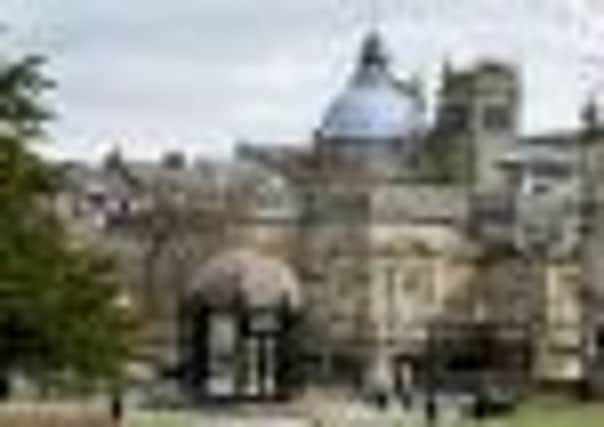Profile on...


FROM the royal dynasties of old Europe and great kings of India, to coachloads of pensioners being bused in from over the Pennines – Harrogate has been defined by its visitors.
As two North Yorkshire villages nestling at the foot of the Dales and dwarfed by nearby Knaresborough, they first started attracting interest in the 16th century when the mineral content of the waters from underground springs began to be discovered and appreciated.
Advertisement
Hide AdAdvertisement
Hide AdAnd as legend of their health-giving properties spread, the tourists came flocking, transforming Harrogate into the world-famous spa town it is today.


Soon, it became one of the key destinations for the young elites on the Grand Tour of Europe – where they would spend several years crossing the Continent accompanied by an entourage of tutors and porters, to broaden their horizons.
In Harrogate, lines of people could be seen every day, snaking around its sweet and sulphur wells, to bathe or to be dispensed gulps of water by entrepreneurial local ‘well women’ brandishing long ebony wands with beakers attached.
The well women were not the only ones to make use of Harrogate’s new-found fame. As the visitor numbers grew, the town rocketed in size. In the 18th century, a number of giant coaching inns were built – the Queen’s Head (today the Cedar Court Hotel), the Dragon, the Crown Hotel and the Granby.
Advertisement
Hide AdAdvertisement
Hide AdNot long after, came the Montpellier Baths (now the Royal Baths) an assembly rooms for visitors (now the Mercer Art Gallery) and the Royal Pump Room, to cover the “stinking well”, Europe’s strongest sulphur well.
A social scene soon sprang up, revolving around dinners, dances and mornings spent whiling away hours over newspapers and coffee.
Famous faces followed. Lord Castlereagh, former Foreign Secretary during the Napoleonic Wars and one of the most powerful men in the world, and Queen Victoria’s son the Duke of Connaught, travelled to Harrogate.
One of its famous literary visitors, Charles Dickens, described the life of leisure he discovered in Harrogate as, “the queerest place, with the strangest people leading the oddest lives.” Later, one of the Maharajas of India also travelled here for some respite.
Advertisement
Hide AdAdvertisement
Hide AdThe meteoric rise of the town meant that during the 1920sit became a magnet for a different type of visitor – the coach tripper. Many in the town turned their noses up at this new influx who nevertheless kept coming in droves.
Despite their social initial reservations, locals were prepared to forget them so long as the tills kept ringing. Soon the tea rooms and independent shops started to spring up around town.
As more tourists chose to wander though the Valley Gardens and the 200 acres of the Stray, or take tea in its grand cafes, so the spa trade slowly dwindled. Its waters were no longer fashionable or used by health-conscious crowds. But with the new style of visitor, came the new Harrogate.
In the late 1950s, the first exhibition centre was built on a stunning stretch of rose gardens, behind the Royal Hall and the foundations of the town’s latest transformation were laid,
Advertisement
Hide AdAdvertisement
Hide AdHarrogate’s International Centre is now one of the cornerstones of its economy, in the height of the recession it pumped £92m into the spa town in just six months and hosts scores of major events, meetings and seminars every year.
But alongside the tens of thousands of businessmen and women every year, the trippers have continued to come. Every day coaches still park up alongside the Stray and the queues snake around Harrogate’s most popular attractions.
Even the famous faces still make an appearance, from time to time.
While its grand sandstone buildings and immaculate green spaces stand testament to the moneyed visitors who forged its reputation, the modern-day Harrogate is harder to define.
Advertisement
Hide AdAdvertisement
Hide AdIt is a town of thriving enterprise, with many small start-up businesses operating successfully alongside huge operations such as Taylor’s of Harrogate tea and coffee merchants and Farrah’s toffee manufacturers.
The Great Yorkshire Showground is on its doorstep and its new upmarket showcase for Yorkshire produce called Fodder and run by the Yorkshire Agricultural Society, is regarded as one of the best of its type in the country.
It is home for many commuters to Leeds, with highly regarded schools equipped with some wonderful facilities. House prices are among the most expensive in Yorkshire.
Harrogate may have had humble beginnings, but life in the spa town now bubbles up far above its wells.
It must be something in the water.
SPRINGS AND STRAY STILL DRAW CROWDS
Advertisement
Hide AdAdvertisement
Hide Ad* The chalybeate, iron, springs were first discovered in High Harrogate and the sulphur springs in Low Harrogate – historically, two separate villages which were later joined together to make up the town.
* Nearly half of all Harrogate’s mineral wells are believed to be found in the Grade II listed Valley Gardens, which covers 17 acres.
* The Stray was established on August 19, 1778, when the Duchy of Lancaster issued a formal decree protecting 200 acres of open common in Harrogate.
* Harrogate has won 35 major awards in as many years for its floral displays, and in 2009 scooped a Gold Award and was declared winner in the Royal Horticultural Society’s Britain in Bloom.